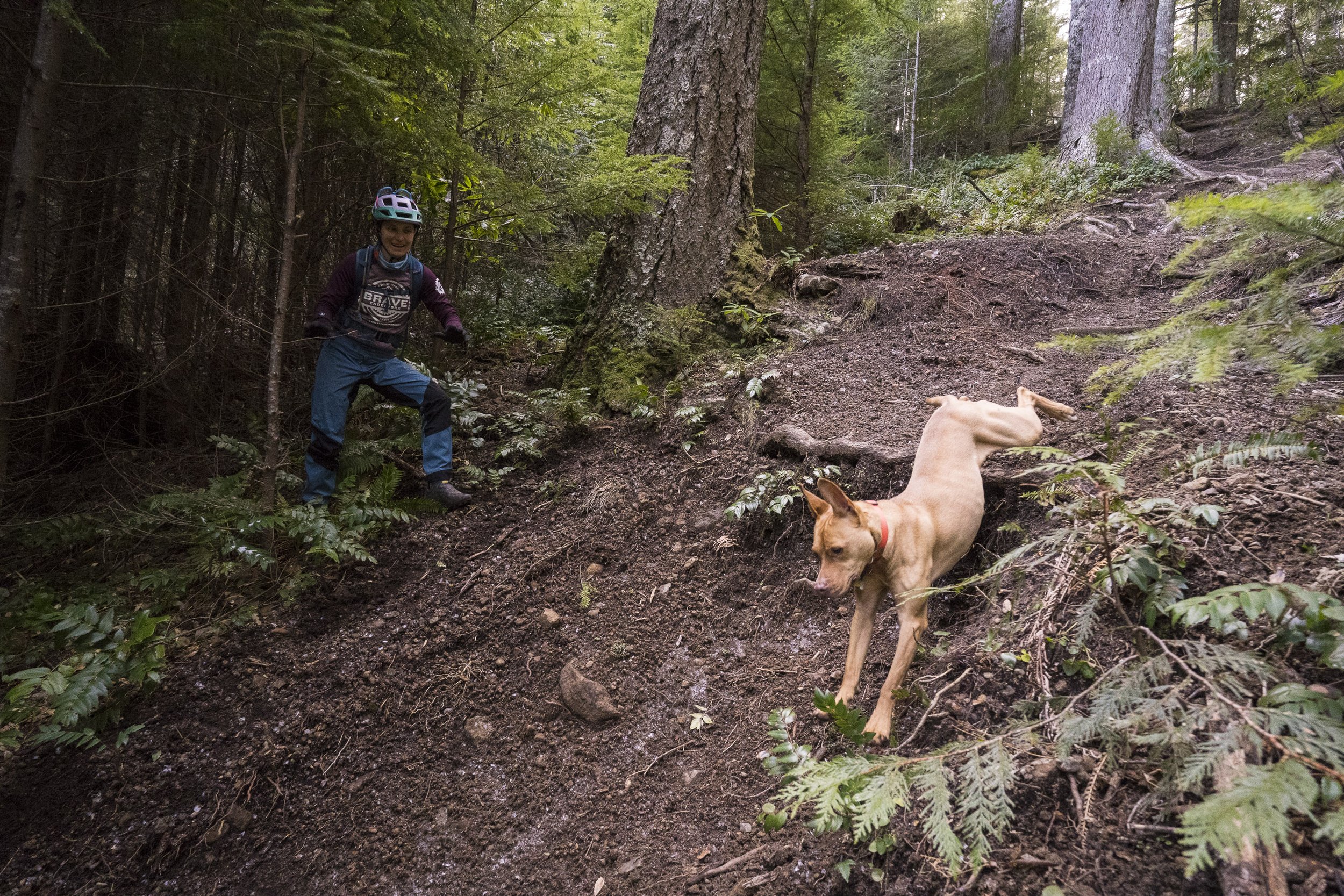Ride Faster with Better Braking
Braking: The Most Important,
but least sexy skill.
Braking, is not the fun part of mountain biking. A client has yet to show up at a clinic and announce, “I want to work on my braking!” It is, however, one of the top 3 foundational MTB skills, and as the word foundation implies, if you’re braking isn’t dialed, it’s hard to improve your overall MTB skills. When I sat down to write this I had no idea I could easily jot down 1,000 words on the topic of braking. But, I guess that’s what happens when you’ve been a mountain bike coach for 7 years. When you reach the end of this article, I can guarantee two things:
You’ll have a new appreciation for the intricacies of braking
You’ll know exactly when you should brake on the trail and when you should not brake on the trail
You’ll ride faster on your next ride:)
Let’s start with the fundamental problem of braking: braking is a loss of traction. Braking leads to less grip between the tires and the ground, and if you brake hard enough you’ll create a skid: the ultimate loss of traction. Traction is improved as wheels accelerate over the ground, not as they decelerate. Remember in Driver’s Ed you were taught to brake before the turn? You have less traction when turning, thus, adding a braking force to a turning force equates to a double loss of traction. The exact same is true on the mountain bike (or any bike for that matter). But a common problem you’ve most likely encountered: Loss of traction = loss of control. Loss of control = scary which often equals…more braking:/ shoot. Let’s fix that!
Let’s assume we all want the same thing on the bike: we want to feel in control. When we are in control, our confidence increases and we have more fun! Sounds great.
WHEN to Brake:
You want to have done the majority of your braking BEFORE you hit a gnarly section of trail with rocks, roots, or drops.
BEFORE. Brake before the rocks, before roots, before the turn, before the chunky stuff. Ideally brake in the straightest and smoothest section of trail. This is where you have the most traction. Remember, braking is an inherent loss of traction. So if you are braking (loss of traction) in part of the trail that already has less traction) well, less traction + less traction = a lot less traction :) So do the majority of your braking in the part of the trail that has the most traction! This will set you up for success as you move into a harder section of trail.
How to Brake:
Gradually, slowly, with control. I’m specifically referring to the way your finger interacts with your brake levers. Gradually, slowly, and with control. Use one finger on the brake lever in order to: maximize brake lever control and maximize hand and finger contact with the bars. And please, since we’re talking about digits, wrap your thumb around the bars (don’t let your hitch hiking digit hang out on top of the bars like a sunbather trying to catch a tan!). Pulling the brake lever violently leaves you with a rapid loss of traction and can result in two things: 1) Skidding 2) Flipping OTB if your body is in the wrong position (we covered that in depth last week). A few of my favorite analogies for ways to think about the brake levers: Treat your brakes like a dimmer switch, set the mood lighting. Treat your brakes like a tube of toothpaste, you just want a little, not the entire tube! When you are riding, keep your index finger resting on your brake levers at all times. This is called “covering the brakes.” Even when riding uphill it can be helpful to come to a quick stop in the case of struggling up a gnarly rock section or a rapid encounter with a rattlesnake! I think of riding my bike with my fingers on the brake levers like a seat belt. If I’m driving in a car, my seat belt is on. If I’m riding my bike, I’m covering the brake levers! Safety first!
Which brakes to Use:
Moxidog goes full send 100% of the time. Do not follow her lead for when to brake :)
Both brakes. Use both brakes. That means use your back brake AND your front brake and use them evenly. But I thought… OK ok, there is more nuance. But, if you are like me and have a hard time remembering lots of information, or if you are newer to learning the finer points of mountain biking, the main 3 points I want you to remember are: Use both brakes! Use them gently, and brake BEFORE you need to.
For those of you who want the more nuanced story of braking, here it is:
When entering high speed turns (this includes flat turns, berms, and could even apply to downhill switchbacks). Start braking with both brakes (reference when to brake). If you find you need to decrease your speed more as you enter the turn, only use your back brake. In an ideal world you are off the brakes by the apex (the sharpest point of the turn). The saying “two, one, none” is open applied here and since it rhymes, may help you remember: brake with two brakes BEFORE you enter the turn. As you start leaning the bike into the turn and your body away from the turn you could apply one brake (the back brake), and before you roll through the apex of the turn you let off all the brakes (none). Letting off your brakes before you’re all the way into the turn will allow you to exit the turn with more speed. You may have heard the saying “enter slow, exit fast.” This will allow you to ultimately carry more speed through the trail and be more efficient. Rather than slamming on your brakes and finding yourself needing to pedal out of the turn which is exhausting.
When riding down STEEP AF rock slabs: Front brake front brake front brake. Using too much back brake can be dangerous on steep AF rock slabs as it can lead to your back wheel skidding and then fishtailing and then crashing. Steep AF rock slabs are one the of the few times you want to use far more front brake than back brake AND apply more pressure to the bars with your hands than you normally do when riding reasonable terrain. Steep AF rock slabs are an advanced feature, can be really fun and rewarding, but should be approached with caution.
Another really important often misunderstood nuance:
I always ride with my “seatbelt on.” This means my index fingers rest on my brake levers 100% of the time. Safety first!
Drag, don’t feather. Feathering your brakes is equivalent to pumping your car brakes (before there were antilock brakes). It’s the action of applying quick brake pressure, then letting off, then applying quick pressure again, then letting off…Does that seem like a good idea?? Feathering, even though it sounds soft and gentle, creates a jolting motion that makes it harder for you to control both your body and your bike. Instead of feathering your brakes, go ahead and drag your brakes. This is like driving down a steep hill and applying consistent, but gently, pressure to the brake pedal until you’re at the bottom of the hill. Can you imagine driving down a hill with someone who was feathering, or pumping their brakes? You’d throw up! Which is what your bike will want to do to you if you feather your way down a steep, techy, gnarly section of trail. When do you want to drag your brakes? When going down steep gnarly things and you don’t feel comfortable (yet) completely letting off the brakes. Dragging your brakes is sort of like setting cruise control: It allows you to better control your speed AND maintain traction.
Practice Tips
I completely realize all of this seems straight forward enough, when reading, but putting these tactics to use out on the trail is hard. Very hard. Below are a few ways to help you improve the feel of your bike and apply these tips in real life.
Practice riding uphill while dragging your brakes. This will help improve your brake finger dexterity (yes, this is a real thing and important for good braking) and will help you develop a feel for your particular brakes. Another analogy I like to use when I’m coaching: Think of the last time you borrowed a friend's car, or test drove a new car. You probably hit the brakes and everyone and everything in the car went flying forwards, OR you rolled through the stop sign. Either way, you weren’t familiar with the feel of the brakes on that new car. The same is true of your bicycle brakes. You need to put in the time in order to develop a solid and trusting relationship:) Your brake levers should feel like an extension of your hand. This will come with practice!
Focus on brake points: optimal places in the trail to brake. The next time you’re out riding pick a section of trail where the main think you focus on is braking BEFORE. Before the turn, before the chunk, before the steep sketchy thing... You’ll be amazed how this changes your riding and you’ll start to view the trail differently. This drill is also really good for helping you to look farther ahead down the trail.
I hope you find this helpful! I’m honestly amazed I have so much to say about braking, but that simply demonstrates my main point: Braking is the most important, but least sexy skill. Go ahead and put these tips to use, and let me know if you get some new PRs! If you’re looking for individual attention, the absolute best way to improve is with a lesson! Sign up for a skills clinic in Hood River, OR or Boise!




